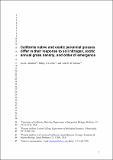California native and exotic perennial grasses differ in their response to soil nitrogen, exotic annual grass density, and order of emergence
Author(s)
D'Antonio, Carla M.; Corbin, Jeffrey D.; Abraham, Joel K.
DownloadAbraham_California native.pdf (868.0Kb)
PUBLISHER_POLICY
Publisher Policy
Article is made available in accordance with the publisher's policy and may be subject to US copyright law. Please refer to the publisher's site for terms of use.
Terms of use
Metadata
Show full item recordAbstract
Early emergence of plant seedlings can offer strong competitive advantages over later-germinating neighbors through the preemption of limiting resources. This phenomenon may have contributed to the persistent dominance of European annual grasses over native perennial grasses in California grasslands, since the former species typically germinate earlier in the growing season than the latter and grow rapidly after establishing. Recently, European perennial grasses have been spreading into both non-native annual and native perennial coastal grass stands in California. These exotic perennials appear to be less affected by the priority effects arising from earlier germination by European annual grasses. In addition, these species interactions in California grasslands may be mediated by increasing anthropogenic or natural soil nitrogen inputs. We conducted a greenhouse experiment to test the effects of order of emergence and annual grass seedling density on native and exotic perennial grass seedling performance across different levels of nitrogen availability. We manipulated the order of emergence and density of an exotic annual grass (Bromus diandrus) grown with either Nassella pulchra (native perennial grass), Festuca rubra (native perennial grass), or Holcus lanatus (exotic perennial grass), with and without added nitrogen. Earlier B. diandrus emergence and higher B. diandrus density resulted in greater reduction in the aboveground productivity of the perennial grasses. However, B. diandrus suppressed both native perennials to a greater extent than it did H. lanatus. Nitrogen addition had no effect on the productivity of native perennials, but greatly increased the growth of the exotic perennial H. lanatus, grown with B. diandrus. These results suggest that the order of emergence of exotic annual versus native perennial grass seedlings could play an important role in the continued dominance of exotic annual grasses in California. The expansion of the exotic perennial grass H. lanatus in coastal California may be linked to its higher tolerance of earlier-emerging annual grasses and its ability to access soil resources amidst high densities of annual grasses.
Date issued
2009-04Department
Massachusetts Institute of Technology. Department of Urban Studies and Planning; Massachusetts Institute of Technology. Department of Urban Studies and PlanningJournal
Plant Ecology
Publisher
Springer Netherlands
Citation
J. Abraham, J. Corbin, and C. D’Antonio, “California native and exotic perennial grasses differ in their response to soil nitrogen, exotic annual grass density, and order of emergence,” Plant Ecology, vol. 201, Apr. 2009, pp. 445-456.
Version: Author's final manuscript
ISSN
1573-5052
1385-0237
Keywords
seedling dynamics, invasion, fertilization, priority effects, exotic species, germination